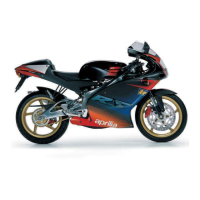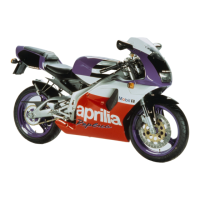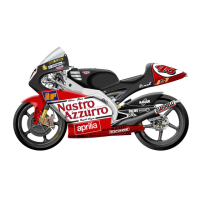60
use and maintenance RS 125
The adjusting nut must not be
screwed for more than 25 mm
from the beginning of the thread
(see figure). If this measure is
exceeded, even the slightest
unevenness on the road surface will
cause sudden jerks.
u
Act on the adjusting nut (1) (shock
absorber spring preload adjustment)
(see figure).
Turn the adjusting nut (1) one
turn at a time.
Test the vehicle repeatedly on
the road, until obtaining the optimal
adjustment.
CHECKING THE BRAKE PAD WEAR
Carefully read page 26 (BRAKE FLUID-
recommendations), page 26 (DISC
BRAKES) and page 43
(MAINTENANCE).
The following information refer to a
single braking system, but are valid for
both.
Check the brake pad wear after the first
1000 km (625 mi) and successively every
2000 km (1250 mi).
The wear of the brake pads depends on
the use, on the kind of drive and on the
road. The wear will be greater when the
vehicle is driven on dirty or wet roads.
Check the wear of the brake
pads, especially before every
trip.
To carry out a rapid checking of the wear
of the pads, proceed as follows:
u
Position the vehicle on the stand.
u
Carry out a visual checking of the friction
material thickness by looking between
the brake caliper and the pads.
Proceed:
– from below, on the front part, for the front
brake caliper (1);
– from below, on the rear part, for the rear
brake caliper (2).
Adjusting
nut (1)
By
screwing it
(clockwise)
By
unscrewing it
(anticlockwise)
Function Spring
preload
increase
Spring preload
decrease
Attitude The vehicle is
more rigid
The vehicle is
less rigid
Recommen
ded kind of
road
Smooth or
normal roads
Roads with
uneven
surface
Notes Rider and
passenger
Solo rider
1
2
RS_125_UK.book Page 60 Tuesday, June 13, 2006 1:34 PM

